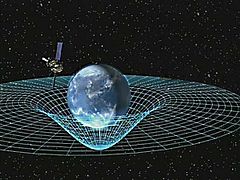User:Halibutt/Spacetime
| Part of a series on |
| Spacetime |
|---|
 |
In physics, spacetime is any mathematical model that fuses the three dimensions of space and the one dimension of time into a single four dimensional continuum. Spacetime diagrams are useful in visualizing and understanding relativistic effects such as how different observers perceive where and when events occur.
Until the turn of the 20th century, the assumption had been that the three-dimensional geometry of the universe (its description in terms of locations, shapes, distances, and directions) was distinct from time (the measurement of when events occur within the universe). However, Albert Einstein's 1905 special theory of relativity postulated that the speed of light through empty space has one definite value—a constant—that is independent of the motion of the light source. Einstein's equations described important consequences of this fact: The distances and times between pairs of events vary when measured in different inertial frames of reference (separate vantage points that aren’t being subjected to g‑forces but have different velocities).
Einstein's theory was framed in terms of kinematics (the study of moving bodies), and showed how quantification of distances and times varied for measurements made in different reference frames. His theory was a breakthrough advance over Lorentz's 1904 theory of electromagnetic phenomena and Poincaré's electrodynamic theory. Although these theories included equations identical to those that Einstein introduced (i.e. the Lorentz transformation), they were essentially ad hoc models proposed to explain the results of various experiments—including the famous Michelson–Morley interferometer experiment—that were extremely difficult to fit into existing paradigms.
In 1908, Hermann Minkowski—once one of the math professors of a young Einstein in Zurich—presented a geometric interpretation of special relativity that fused time and the three spatial dimensions of space into a single four-dimensional continuum now known as Minkowski space. A key feature of this interpretation is the definition of a spacetime interval that combines distance and time. Although measurements of distance and time between events differ for measurements made in different reference frames, the spacetime interval is independent of the inertial frame of reference in which they are recorded.
Minkowski's geometric interpretation of relativity was to prove vital to Einstein's development of his 1915 general theory of relativity, wherein he showed how mass and energy curve this flat spacetime to a Pseudo Riemannian manifold.
Cite error: There are <ref group=note> tags on this page, but the references will not show without a {{reflist|group=note}} template (see the help page).
